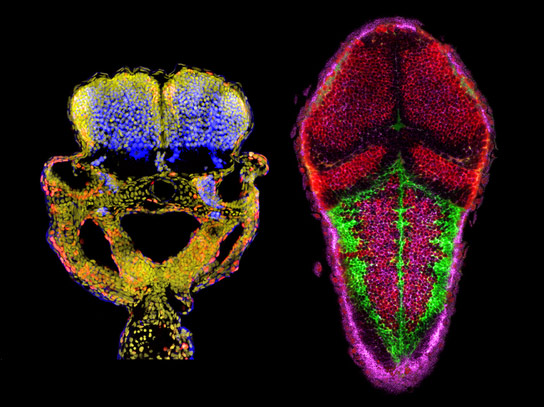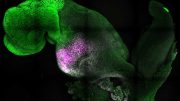
Left, hindbrain of zebrafish embryo at 48 hours post fertilization shows an increase of neurogenesis. Right, dorsal view of a Zebrafish embryo treated for miR-107. Credit: Emma Ristori
By studying miR-107 in zebrafish, Yale researchers have discovered that miR-107 plays a key role in early brain development, and perhaps in the development of brain-related disease.
MicroRNA are the tiny non-coding RNA molecules that help determine whether genes are expressed or silenced. One particular microRNA — miR-107 — plays a key role in early brain development, and perhaps in the development of brain-related disease, a Yale School of Medicine team has found.
Experts have long known that miRNAs are involved in brain development but not precisely how. Assistant professor of medicine Stefania Nicoli and her team set out to describe the process by studying miR-107 in zebrafish. They discovered that miR-107 regulates the levels of an enzyme known as dicer, which in turn regulates another RNA molecule, miR-9, that is essential to normal brain development. This regulatory loop was previously unknown.
Though miR-107 has been studied previously in cancer progression and diabetes, the Yale team observed how it impacts brain development in an animal for the first time. The loss of miR-107 in the zebrafish led to an excessive amount of neurons (nerve cells) and neural progenitors.
“This is the first paper showing that if you lose miR-107, you have abnormal embryonic hindbrain development,” said Nicoli. Understanding this miRNA’s functions may be essential to understanding the genetic and cellular basis of neural disorders that can occur during brain development, she notes.
The study findings may also point to future research into treatment for adult neurological disorders involving miR-107, the expression of which is dramatically lost in the brain of early Alzheimer’s patients, the paper noted.
The study was published early online in the journal Developmental Cell.
Other authors included Emma Ristori, Miguel Alejandro Lopez-Ramirez, Anand Narayanan, Guillermina Hill-Teran, Albertomaria Moro, Charles-Felix Calvo, and Jean Leon Thomas.
It was supported by grants from the National Institute of Health (5R00HL105791) and from the Alzheimer’s Association (NIRP 12-259162).
Reference: “A Dicer-miR-107 Interaction Regulates Biogenesis of Specific miRNAs Crucial for Neurogenesis” by Emma Ristori, Miguel Alejandro Lopez-Ramirez, Anand Narayanan, Guillermina Hill-Teran, Albertomaria Moro, Charles-Félix Calvo, Jean-Léon Thomas and Stefania Nicoli, 5 February 2015, Developmental Cell.
DOI: 10.1016/j.devcel.2014.12.013








Be the first to comment on "Key Process in Brain Development Identified"